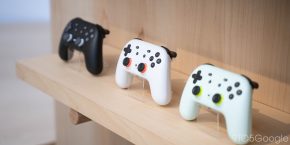
With Stadia launching in a matter of days, Google has been detailing the more granular aspects of how to actually use the game streaming service. Yesterday’s AMA provided an overview of the Android, iOS, and TV interface, while Google today is breaking down the Stadia Controller.
New diagrams identify every part and button on the Made by Google accessory. All controllers have console-specific actions, with Stadia’s ellipsis button for “Options” and the hamburger icon opening “Menu.” Pressing down on both for 5 seconds activates Stadia’s Chromecast screen reader.
There’s of course the “Google Assistant” and “Capture” button below. The former does not need to be held down while you issue a voice command, while a tap on the latter saves a screenshot and holding down creates a clip.
The Stadia icon between the two thumbstucks serves as a button and “Status Light.” To turn on the platform, you hold down for a second until the controller vibrates. Off is achieved by pressing for 4 seconds, while 8 is a “hard power down” in case the accessory become unresponsive.
A quick tap of the button opens the “Stadia menu” for: See your profile information, Check your Wi-Fi connection status, Adjust audio levels, Start a party, View notifications, or Exit game.
Holding it down for 1 second lets you access the “platform menu” to: Resume game, Turn the controller off, Exit game, Sign out, or Shut down.
The light has several states with “Solid white” meaning that the Controller is on and linked to a screen. “Blinking white” means the device is awaiting a linking code, while “Blinking orange” means Wi-Fi is required and to open the Stadia app. The light stays “Solid orange” during charging and will turn off once complete. When Assistant is active, the light will “blink in a series of two short flashes followed by a pause.”
Besides standard bumpers, triggers, directional pad, and A/B/X/Y buttons, Google identifies the left and right vibration motors housed in the grips and microphone just underneath the 3.5mm headset jack — Bluetooth audio support is coming later. A USB-C port is up top for wired gameplay and charging, but Google has yet to provide any official battery life estimates.

FTC: We use income earning auto affiliate links. More.



Comments